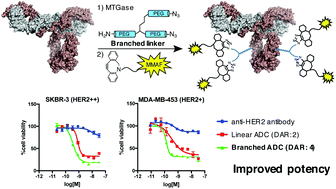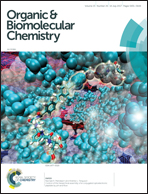Enzymatic conjugation using branched linkers for constructing homogeneous antibody–drug conjugates with high potency†
Abstract
Antibody–drug conjugates (ADCs) are emerging therapeutic agents in the treatment of cancer, and various conjugation strategies and chemical linkers have been developed to efficiently construct ADCs. Despite previous extensive efforts for improving conjugation efficiency and ADC homogeneity, most ADC linkers developed to date load only single payloads. Branched linkers that can load multiple payload molecules have yet to be fully explored. It is logical to envisage that a multi-loading strategy allows for increase in drug-to-antibody ratio (DAR) with less chemical or enzymatic modification to the antibody structure compared to traditional linear linkers, leading to efficient ADC construction, minimal destabilization of the antibody structure, and enhanced ADC efficacy. Herein, we report that the branched linkers we designed can be quantitatively installed on an anti-HER2 monoclonal antibody by microbial transglutaminase (MTGase)-mediated conjugation without impairing its antigen binding affinity, enabling modular installation of payload molecules and construction of homogeneous ADCs with increased DARs (up to 8). An anti-HER2 antibody–monomethyl auristatin F conjugate constructed using our branched linkers showed greater in vitro cytotoxicity against HER2-expressing breast cancer cell lines than that consisting of linear linkers, demonstrating the effectiveness of the branched linker-based payload delivery. Our finding demonstrates that enzymatic ADC construction using branched linkers is a promising strategy, which may lead to innovative cancer therapeutics.



 Please wait while we load your content...
Please wait while we load your content...